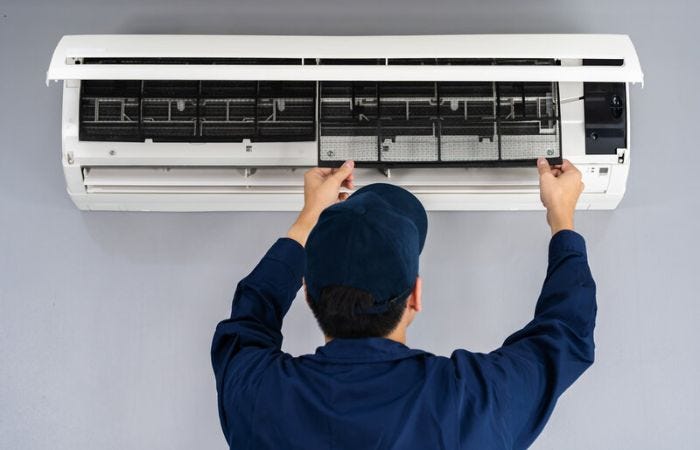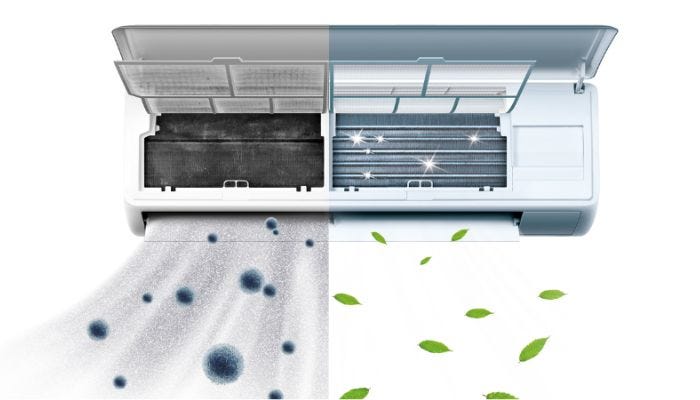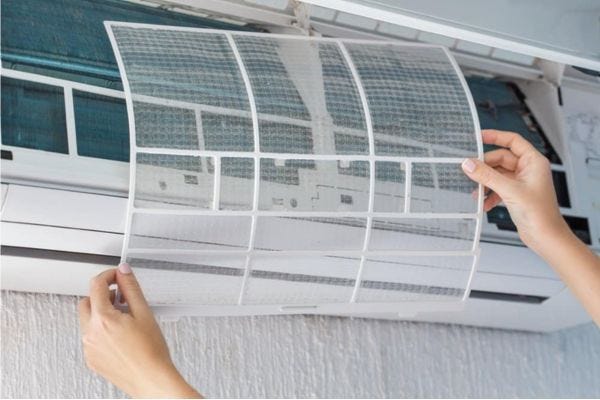How do I Change My Air Conditioner Air Filter?


Air filters are an essential part of your air conditioner unit. It keeps the air cooling system free of allergens, dust, pollen, or any other debris.
When your AC filters are covered with a deep layer of dirt, it can impact on your total AC system's functioning. As a result, it will make the filter useless and require costly repairs.
A dirty, unchanged air filter is the main reason for heating an air conditioner unit. It causes water damage and moldy ductwork for your unit. Hence, you need to replace the air filter unit for the better cooling performance of your AC.Here we arranged everything about how to know when it's time to clean and replacethe air filter. Let's dive into the details.
Signs of Air Filters Degradation and It's Time for a Change
Your air conditioner filter is responsible for keeping the air fresh. But like other things, AC air filters should be replaced on time. The way to identify the time of your filter replacement is by checking it after a regular interval.


To check the air filter, bring it out and hold on to the light. Below are the signs of dirty filters:
Reduced Airflow: If you notice your air conditioner isn't blowing enough air, it could be a sign of a clogged air filter. A dirty filter restricts airflow and leads your air conditioner to work harder. You must clean the air filter when you find airflow reduction.
Higher Energy Bills: A dirty air filter can also lead to higher energy bills. Your air conditioner has to work harder to cool your home when the filter is dirty. That is why it consumes more energy.
Visible Dirt: If you can see dirt and dust on your air filter, it's time for change.
Uneven Cooling: If certain areas of your home are not being adequately cooled, it could be due to a blocked air filter restricting airflow to those areas.
Strange Odors: An unpleasant smell from your vents could indicate mold or mildew growth on a dirty air filter.
Allergy Symptoms: If you or your family members are experiencing increased allergy symptoms such as sneezing, coughing, or itchy eyes. It is a sign of poor indoor air quality due to an expired air filter.
Ice Buildup on the Evaporator Coil: A clogged air filter can restrict airflow over the evaporator coil. It leads to ice buildup and potentially causes damage to your AC system.
Note: You should change the air filter regularly, even if you don't notice any of these signs.
Tools and Materials Needed to Change an AC Air Filter
Changing an air conditioner's air filter is a simple task. You can do it in a few minutes. Here are the tools and materials you'll need to do it:
Replacement Filter: Purchase a replacement filter matching the size and type of your existing filter. The filter's size is usually printed on the side of the old filter.
Screwdriver (optional): Some air filters are held in place with screws. If your filter has screws, you'll need a screwdriver to remove them.
Vacuum cleaner (optional): You can use a vacuum cleaner to remove dust and debris from the air filter compartment before installing the new filter.
Gloves (optional): Gloves can protect your hands from dirt and dust when handling the old filter.
Flashlight (optional): A flashlight is to see inside the air filter compartment if it's dark.
Ladder (optional): A ladder may be needed to reach the air filter compartment if it's located high on a wall or ceiling.
Where is the AC Filter Located?
The AC filter is usually located in one of the following places:
Return Air Vent: The return air vent is usually located on the wall or ceiling. The vent draws the air back into the air conditioner.
Air Handler: The air handler is the indoor unit of your air conditioner. It's usually located in a closet or utility room.
Furnace: If you have a forced-air furnace, the air filter may be located inside the furnace cabinet.
A Step-by-Step Guide to Replacing the Air Conditioner Filter
Changing your air conditioner filter is a simple task. You can do it in a few minutes. However, it is important to know how to change the air conditioner filter in-house. Here's a step-by-step guide to help you:
Step 1: Switch off the Air Conditioning Unit.
This is important for safety reasons. It will prevent you from accidentally turning on the air conditioner while you're working on it.
Step 2: Find Where the Air Filter is.
You need to know the location of your air filter to change it. It is usually located at the return air vent, air handler, and furnace.
Step 3. Remove the Old Filter.
Some filters are held in place with screws. Remove the screws first to open the old filter. Then, simply pull the filter out. Be careful not to damage the filter during the opening.
Step 4. Insert the New Filter.
Make sure the new filter is the same size and type. The filter should also be placed in the correct direction. Some filters have arrows to direct the correct airflow.
Step 5. Ensure Proper Installation.
Ensure the filter is in the right place and there are no gaps around the edges. A poorly installed filter can allow unfiltered air to bypass the filter and enter your home.
Step 6. Turn your Air Conditioner back on.
Now your air conditioner air filter is changed, and your air conditioner is clean to run efficiently.
Additional Tips:
- 1. When you change your air filter, try to clean the air conditioner coils.
- 2. If you're not comfortable changing your air filter by yourself, you can call a qualified HVAC technician.
Air Conditioner Filter Maintenance Tip
You should clean and maintain your air conditioner filter to keep it running efficiently. Here are some essential maintenance tips:


Regular Replacement Schedule: You should create a regular cleaning and replacement schedule. Remember the points below about the replacement.
- -Replace the air filter every 1-3 months during peak cooling seasons.
- -Consider more frequent replacements if you have pets or allergies.
- -You should replace it more frequently if you live in a dusty area.
Cleaning Reusable Filters: Some AC air filters are reusable. Two important points about filter cleaning are:
- -Vacuum the filter gently using a soft brush attachment.
- -Rinse it with lukewarm water and let it dry thoroughly before reinstalling.
Professional Maintenance: Professional maintenance can save your air conditioner from any misplacement of the filters. You should
-Schedule professional AC maintenance at least once a year.
-Call a technician to inspect and clean the entire AC unit, including the air filter.
Additional Tips: The tips below will make you an expert at maintaining your air conditioner filter.
- -Use high-quality filters with a MERV rating of 8-13 for optimal efficiency.
- -Mark the installation date on the filter for easy tracking.
- -Keep a spare filter on hand to avoid delays during replacements.
- -Consider upgrading to a whole-house air filtration system for better indoor air quality.
Troubleshooting of Air Conditioner Filters
There are a few common issues to consider when troubleshooting AC filters.
First off, make sure the filter fits accurately in its slot. If it does not fit accurately, air could sneak around the edges instead of getting filtered. That means dirt and dust could be sneaking into your system.
Accessibility problems can also be a headache. If your air filter is tucked away in a hard-to-reach spot, it's easy to forget about it. But regular checks are super important. Set a reminder on your phone to keep on top of it.
Now, let's talk about airflow. If the airflow becomes weak, a dirty filter might be the cause. When it's all clogged up, air can't pass through properly. So you're not getting the refreshing breeze from your AC.
Locate the air filter. It's usually near the return air duct or inside the air handler unit. Once you've found it, give it a visual inspection. If it looks dirty or clogged with dust, it's time for a change.
If you're still having problems, you should check for any other obstructions in the system. Sometimes debris can get lodged in ducts and vents and block airflow. Clearing out any blockages could make a big difference.
Call an HVAC expert to further diagnose the problem if it is not solved.
Environmental Considerations During Changing Air Conditioner Filters
When you're changing your AC air filters, it's important to think about the environment. When your old filter has done its job, you'll need to dispose of it properly. Throwing it in the trash might seem like an easy option, but it's not the most eco-friendly choice.
Look for recycling options in your area. Some places accept used air filters for recycling. It's a great way to reduce waste and give your old filter a new life.
If recycling is not possible, consider how you can minimize the environmental impact of disposal. Some filters are made with mixed materials. Separate the recyclable parts.
Another option is to look for eco-friendly filter alternatives. Some companies offer filters made from sustainable and recyclable materials. So you can buy, considering the environmental issue.
Finally, remember to follow any local regulations or guidelines for disposing of air filters. Some areas have specific rules for handling certain types of waste, so it's worth checking before you throw your old filter in the trash.
FAQS:
1. Where is an AC filter located?
-The AC filter is located at the return vents of your AC unit. It can remain on a wall, on the ceiling, or in any deserted home.
2. Do all AC units have filters?
-Yes, every air conditioner has a filter with a minimum MERV (minimum efficiency reporting value) rating. The highest rating for air filters is 16.
3. How often do you need to change a ceiling air filter?
-You need to change your ceiling air filter every 90 days. It depends on the placement of your home. If you live in an area with a dusty environment, you need to change it sooner.
4. What is an air conditioner filter wall unit?
-An air conditioner filter wall unit is a type of air filter designed specifically for wall-mounted air conditioning units. These filters are installed inside the unit to capture dust, allergens, and other particles from the air.
5. What is split-type AC?
-A split-type air conditioner consists of an outdoor condenser and an indoor air handler. The refrigerant is compressed, cooled, and expanded to cool the air, which is then blown into the room. These air conditioners are efficient, quiet, and versatile, making them a popular choice.
Conclusion
Changing your AC air filters is key to maintaining good air quality in your home. It keeps your system running smoothly. You can ensure your home stays free of dust, allergens, and other airborne particles by replacing your filters on schedule.
Clean filters help your AC system operate more efficiently. It can save you money on your energy bills. So don't forget to check your filters regularly and swap them out when needed. Your lungs—and your wallet—will thank you for it!
We appreciate you visiting our House of Butterfly to learn more about any air conditioner issues.

